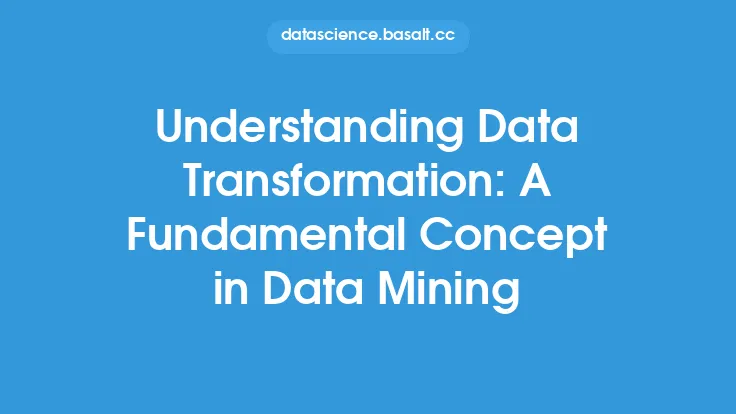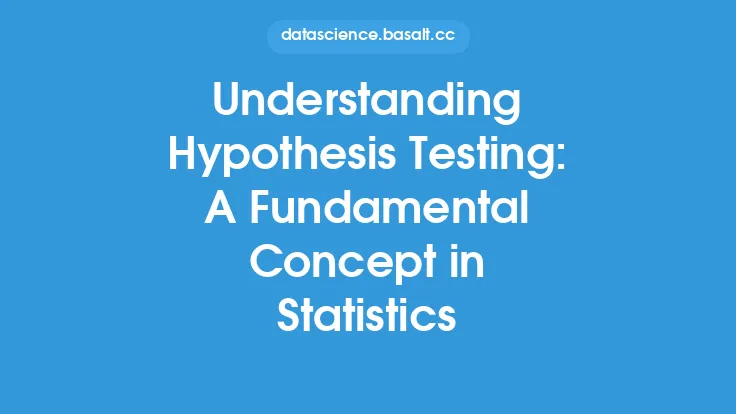Data transformation is a crucial step in the data analysis process, enabling the conversion of raw data into a suitable format for analysis, modeling, and visualization. It involves applying mathematical or statistical techniques to modify the data, making it more suitable for analysis and improving the accuracy of the results. In this article, we will delve into the fundamental concepts of data transformation, its importance, and the various techniques used to transform data.
Introduction to Data Transformation
Data transformation is a process that involves changing the format, scale, or distribution of the data to make it more suitable for analysis. This can include operations such as aggregation, normalization, feature scaling, and encoding. The primary goal of data transformation is to prepare the data for modeling, visualization, or other analytical tasks, ensuring that the results are accurate, reliable, and meaningful. Data transformation is a critical step in the data analysis pipeline, as it can significantly impact the outcome of the analysis and the quality of the insights gained.
Types of Data Transformation
There are several types of data transformation, each serving a specific purpose. Some of the most common types of data transformation include:
- Linear transformation: This involves applying a linear function to the data, such as scaling or shifting, to change its distribution or scale.
- Non-linear transformation: This involves applying a non-linear function to the data, such as logarithmic or exponential, to change its distribution or scale.
- Normalization: This involves scaling the data to a common range, usually between 0 and 1, to prevent differences in scales from affecting the analysis.
- Feature scaling: This involves scaling the data to have zero mean and unit variance, which can improve the stability and performance of machine learning models.
- Encoding: This involves converting categorical variables into numerical variables, enabling them to be used in numerical analysis.
Data Transformation Techniques
Several data transformation techniques are used to transform data, including:
- Standardization: This involves subtracting the mean and dividing by the standard deviation for each feature, resulting in data with zero mean and unit variance.
- Min-max scaling: This involves scaling the data to a common range, usually between 0 and 1, by subtracting the minimum value and dividing by the range.
- Log transformation: This involves applying the logarithm function to the data, which can help to stabilize the variance and make the data more normal.
- Square root transformation: This involves applying the square root function to the data, which can help to stabilize the variance and make the data more normal.
- Polynomial transformation: This involves applying a polynomial function to the data, which can help to capture non-linear relationships.
Importance of Data Transformation
Data transformation is essential in data analysis, as it can significantly impact the outcome of the analysis and the quality of the insights gained. Some of the reasons why data transformation is important include:
- Improves model performance: Data transformation can improve the performance of machine learning models by reducing the impact of differences in scales and distributions.
- Enhances data visualization: Data transformation can enhance data visualization by making the data more suitable for visualization and enabling the use of different visualization techniques.
- Reduces noise and outliers: Data transformation can reduce the impact of noise and outliers, resulting in more accurate and reliable results.
- Enables comparison: Data transformation can enable comparison between different datasets or features, which can be challenging when the data has different scales or distributions.
Challenges and Considerations
While data transformation is a powerful tool in data analysis, it also presents several challenges and considerations. Some of the challenges and considerations include:
- Choosing the right transformation: Choosing the right transformation technique can be challenging, as different techniques can have different effects on the data.
- Over-transformation: Over-transformation can result in loss of information and distortion of the data, leading to inaccurate results.
- Under-transformation: Under-transformation can result in poor model performance and inaccurate results, as the data may not be suitable for analysis.
- Interpretability: Data transformation can affect the interpretability of the results, as the transformed data may not be easily understandable.
Best Practices
To ensure effective data transformation, several best practices should be followed, including:
- Understand the data: Understanding the data and its distribution is essential in choosing the right transformation technique.
- Choose the right technique: Choosing the right transformation technique depends on the type of data, the analysis task, and the desired outcome.
- Evaluate the results: Evaluating the results of the transformation is essential in ensuring that the transformation has achieved the desired outcome.
- Document the transformation: Documenting the transformation is essential in ensuring reproducibility and interpretability of the results.
Conclusion
Data transformation is a fundamental concept in data analysis, enabling the conversion of raw data into a suitable format for analysis, modeling, and visualization. Understanding the different types of data transformation, techniques, and best practices is essential in ensuring effective data transformation and accurate results. By applying data transformation techniques, data analysts can improve the quality of the data, reduce noise and outliers, and enhance the performance of machine learning models. As data analysis continues to evolve, the importance of data transformation will only continue to grow, making it a critical skill for data analysts and scientists to master.





